
A sepal is a part of the flower of angiosperms. Usually green, sepals typically function as protection for the flower in bud, and often as support for the petals when in bloom.
In anatomy, an apex is part of the shell of a mollusk. The apex is the pointed tip of the shell of a gastropod, scaphopod, or cephalopod.

The aperture is an opening in certain kinds of mollusc shells: it is the main opening of the shell, where the head-foot part of the body of the animal emerges for locomotion, feeding, etc.

Equisetidae is one of the four subclasses of Polypodiopsida (ferns), a group of vascular plants with a fossil record going back to the Devonian. They are commonly known as horsetails. They typically grow in wet areas, with whorls of needle-like branches radiating at regular intervals from a single vertical stem.

A whorl is a single, complete 360° revolution or turn in the spiral or whorled growth of a mollusc shell. A spiral configuration of the shell is found in numerous gastropods, but it is also found in shelled cephalopods including Nautilus, Spirula and the large extinct subclass of cephalopods known as the ammonites.
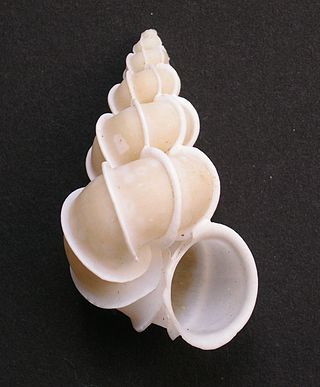
Sculpture is a feature of many of the shells of mollusks. It is three-dimensional ornamentation on the outer surface of the shell, as distinct from either the basic shape of the shell itself or the pattern of colouration, if any. Sculpture is a feature found in the shells of gastropods, bivalves, and scaphopods. The word "sculpture" is also applied to surface features of the aptychus of ammonites, and to the outer surface of some calcareous opercula of marine gastropods such as some species in the family Trochidae.
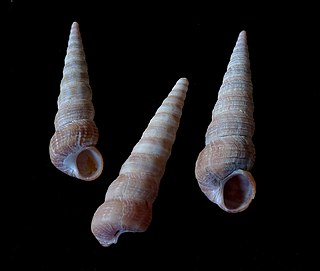
A spire is a part of the coiled shell of molluscs. The spire consists of all of the whorls except for the body whorl. Each spire whorl represents a rotation of 360°. A spire is part of the shell of a snail, a gastropod mollusc, a gastropod shell, and also the whorls of the shell in ammonites, which are fossil shelled cephalopods.

A whorl is an individual circle, oval, volution or equivalent in a whorled pattern, which consists of a spiral or multiple concentric objects.

A protoconch is an embryonic or larval shell which occurs in some classes of molluscs, e.g., the initial chamber of an ammonite or the larval shell of a gastropod. In older texts it is also called "nucleus". The protoconch may sometimes consist of several whorls, but when this is the case, the whorls show no growth lines.

The gastropod shell is part of the body of many gastropods, including snails, a kind of mollusc. The shell is an exoskeleton, which protects from predators, mechanical damage, and dehydration, but also serves for muscle attachment and calcium storage. Some gastropods appear shell-less (slugs) but may have a remnant within the mantle, or in some cases the shell is reduced such that the body cannot be retracted within it (semi-slug). Some snails also possess an operculum that seals the opening of the shell, known as the aperture, which provides further protection. The study of mollusc shells is known as conchology. The biological study of gastropods, and other molluscs in general, is malacology. Shell morphology terms vary by species group.
Syringonautilidae is a family of Nautiloidea from the middle to late Triassic. Syringonautilidae comprise the last of the Trigonoceratoidea and are the source for the Nautilaceae which continued the Nautiloidea through the Mesozoic and into the Cenozoic right down to the recent. Syringonautilidae is a strictly Triassic family, derived early in the Triassic from the Grypoceratidae.
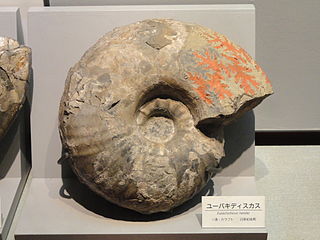
Eupachydisus is a large, coarse-ribbed Pachydiscid ammonite genus from the Upper Cretaceous, found in Coniacian to Campanian age strata in Europe, Madagascar, Japan, and British Columbia.

Fusiturricula fenimorei, common name Fenimore's turrid, is a species of sea snail, a marine gastropod mollusk in the family Drilliidae.
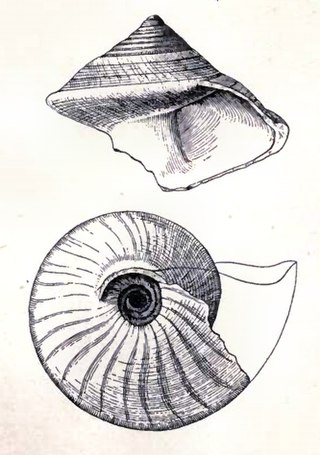
Calliostoma brunneum, is commonly known asTejedor top shell. It is a species of sea snail, a marine gastropod mollusk in the family Calliostomatidae.
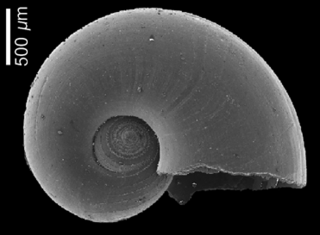
Protatlanta rotundata is an extinct species of sea snail, a holoplanktonic marine gastropod mollusk in the family Atlantidae.

Didymoceras nebrascense was an extinct species of heteromorph ammonite from the upper Campanian age. It was sexually dimorphic, with two adult sizes averaging at 270 mm (11 in) and 180 mm (7.1 in) high for females and males respectively. It exhibited three distinct growth stages. The first growth stage was composed of one or two straight sharply bending sections and a gently curved third. The second growth stage is composed of around three and a half loosely coiling whorls. The last (adult) growth stage is composed of a U-shaped bend facing upwards.

Lytoceratidae is a taxonomic family of ammonoid cephalopods belonging to the suborder Lytoceratina, characterized by very evolute shells that generally enlarge rapidly, having whorls in contact but mostly overlapping very sightly, or not at all.
Bisatoceras is a late Paleozoic Ammonoidea, a member of the goniatitid family Bisatoceratidae.

Lytoceratinae is a subfamily of ammonoid cephalopods that make up part of the family Lytoceratidae.
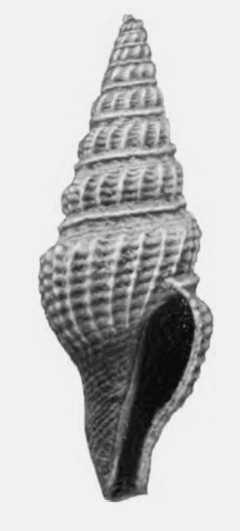
Crassispira calligona is an extinct species of sea snail, a marine gastropod mollusk in the family Pseudomelatomidae, the turrids and allies.

















